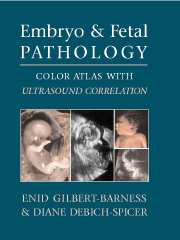Book contents
- Frontmatter
- Contents
- Foreword by John M. Opitz
- Preface
- Acknowledgments
- 1 The Human Embryo and Embryonic Growth Disorganization
- 2 Late Fetal Death, Stillbirth, and Neonatal Death
- 3 Fetal Autopsy
- 4 Ultrasound of Embryo and Fetus: General Principles
- 5 Abnormalities of Placenta
- 6 Chromosomal Abnormalities in the Embryo and Fetus
- 7 Terminology of Errors of Morphogenesis
- 8 Malformation Syndromes
- 9 Dysplasias
- 10 Disruptions and Amnion Rupture Sequence
- 11 Intrauterine Growth Retardation
- 12 Fetal Hydrops and Cystic Hygroma
- 13 Central Nervous System Defects
- 14 Craniofacial Defects
- 15 Skeletal Abnormalities
- 16 Cardiovascular System Defects
- 17 Respiratory System
- 18 Gastrointestinal Tract and Liver
- 19 Genito-Urinary System
- 20 Congenital Tumors
- 21 Fetal and Neonatal Skin Disorders
- 22 Intrauterine Infection
- 23 Multiple Gestations and Conjoined Twins
- 24 Metabolic Diseases
- Appendices
- Index
9 - Dysplasias
Published online by Cambridge University Press: 23 February 2010
- Frontmatter
- Contents
- Foreword by John M. Opitz
- Preface
- Acknowledgments
- 1 The Human Embryo and Embryonic Growth Disorganization
- 2 Late Fetal Death, Stillbirth, and Neonatal Death
- 3 Fetal Autopsy
- 4 Ultrasound of Embryo and Fetus: General Principles
- 5 Abnormalities of Placenta
- 6 Chromosomal Abnormalities in the Embryo and Fetus
- 7 Terminology of Errors of Morphogenesis
- 8 Malformation Syndromes
- 9 Dysplasias
- 10 Disruptions and Amnion Rupture Sequence
- 11 Intrauterine Growth Retardation
- 12 Fetal Hydrops and Cystic Hygroma
- 13 Central Nervous System Defects
- 14 Craniofacial Defects
- 15 Skeletal Abnormalities
- 16 Cardiovascular System Defects
- 17 Respiratory System
- 18 Gastrointestinal Tract and Liver
- 19 Genito-Urinary System
- 20 Congenital Tumors
- 21 Fetal and Neonatal Skin Disorders
- 22 Intrauterine Infection
- 23 Multiple Gestations and Conjoined Twins
- 24 Metabolic Diseases
- Appendices
- Index
Summary
Dysplasias are defects of tissue differentiation or defects of histogenesis. These involve principally connective tissue, bone, blood vessels, skin. Dysplasias are characterized by the abnormal growth of tissues. They are frequently caused by autosomal dominantmutations, rarely by the homozygous state of recessive mutations. Occasionally caused by teratogens, dysplasias are not biochemically defined. They are primarily expressed as extensive, multiple, or generalized abnormalities of one type of tissue.
CONNECTIVE TISSUE DYSPLASIAS
Neurofibromatosis (von Recklinghausen Disease) (OMIM *162200)
Neurofibromatosis is inherited as an autosomal dominant trait; 50% represent a new mutation.
Type I, peripheral neurofibromatosis, affects 1 in 4,000 live births; the gene is on chromosome 17. It is associated with the presence of six or more caféau- lait spots more than 5 mm in diameter in children; neurofibromas and plexiform neurofibromas occur along nerves (Figures 9.1 to 9.7 and Tables 9.1 to 9.3). Hamartomatous lesions include lipomas, angiomas, optic gliomas, iris hamartomas, sphenoid dysplasia, and frequently local overgrowth and hemihypertrophy. Malignant change occurs in approximately 3 – 15%. Anintestinal formmay involve the length of the gastrointestinal tract.
Type 2, central neurofibromatosis, has an incidence of 1 in 50,000. The gene is on chromosome 22. It includes acoustic schwannomas, neurofibromas, meningiomas, gliomas, schwannomas, and lenticular opacity.
Type 3 is the intermediate type with neurofibromas limited to the gastrointestinal tract.
Type 4 is a variant form.
Tuberous Sclerosis (See Also Renal Chapter) (TS) (OMIM # 191100)
This is an autosomal dominant mutation; approximately 60% are new mutations.
- Type
- Chapter
- Information
- Embryo and Fetal PathologyColor Atlas with Ultrasound Correlation, pp. 254 - 274Publisher: Cambridge University PressPrint publication year: 2004



